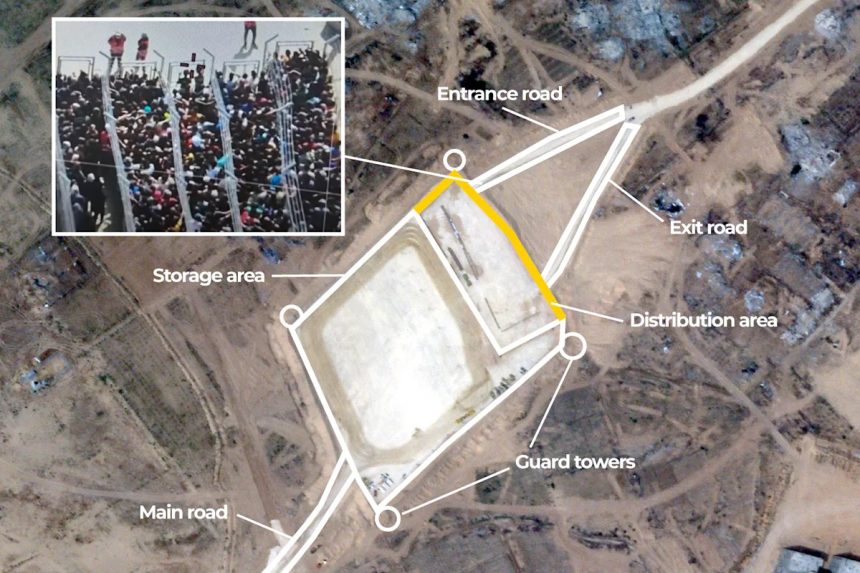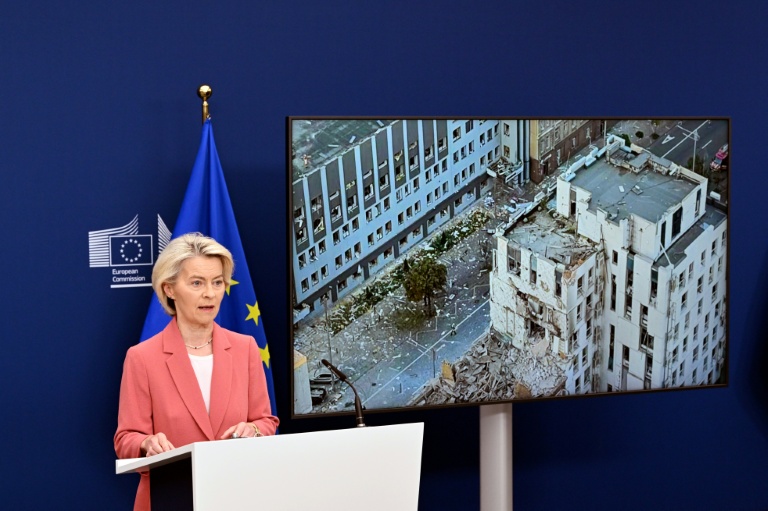A new investigation (PDF) by research group Forensic Architecture (FA) has found that the Israeli military has pursued a deliberate strategy of starvation that has pushed Gaza towards famine.
The report details how Israel has weaponised aid, forcing Palestinians to travel long distances to reach military-run distribution centres in the south of the Strip, while opening fire on those same civilians as they seek aid.
Researchers documented attacks on civilians, the destruction of infrastructure such as food warehouses, and looting by Israeli-backed gangs.
Between March 18 and August 1, 2025, each incident was geolocated and verified using video and satellite imagery, creating a detailed picture of how aid is being manipulated to kill, rather than save, Palestinians.
Aid distribution: Civilian vs military
Israel has dismantled Gaza’s longstanding civilian aid system and replaced it with a militarised one designed to further Israeli military and political goals, while controlling and starving the population.
Until early 2025, aid reached Gaza through UNRWA, international NGOs, and community networks, in line with humanitarian principles. In January, Israel banned UNRWA, and by March, it had halted the entry of aid entirely.
For nearly three months, no aid was allowed in, and when Israel finally eased the blockade under international pressure in late May, the quantities permitted remained far below the minimum needed.
The civilian system was then replaced by the Gaza Humanitarian Foundation (GHF), backed by the US and Israel, which began distributing limited rations through military-controlled stations, creating dependency on a system that observers argue is “deadly by design”.
400 aid sites replaced with four
While the previous UN-led distribution network operated about 400 sites across Gaza, the GHF, guarded by armed private security contractors, has set up only four “mega-sites” for Gaza’s population of about two million people.
The UN and aid groups say the GHF and its model weaponise aid and concentrate it in the south to force people to leave northern Gaza, warning that this could lead to the depopulation of the north, as planned by the Israeli military.
[Al Jazeera]
How the military-run ration stations work
The GHF aid system provides Palestinians with only a minimal, mostly dry, food ration that people have to walk long distances and enter Israeli-controlled military zones to access.
Three stations lie between Rafah and Khan Younis, and a fourth south of the Netzarim Corridor; all are inside areas officially designated as active combat zones.
![The GHF ration stations and the routes designated to reach them, are within areas designated by the Israeli military as ‘dangerous combat zone’ and therefore unsafe for Palestinians [Forensic Architecture]](https://s.yimg.com/ny/api/res/1.2/lBFCKQ2ogk5P314Q.PqPZw--/YXBwaWQ9aGlnaGxhbmRlcjt3PTk2MDtoPTEwMDk7Y2Y9d2VicA--/https://media.zenfs.com/en/al_jazeera_289/4958ef662a71335c27594325c1d891ed)
The GHF ration stations and the routes designated to reach them, are within areas designated by the Israeli military as ‘dangerous combat zone’ and therefore unsafe for Palestinians [Forensic Architecture]
The stations open only briefly, often for a few minutes, and with little advance notice. To avoid missing distributions, families often relocate closer to them. Entry is slow and tightly controlled: people are funnelled through narrow fenced corridors resembling cattle chutes.
The stations provide food only, without water, shelter, sanitation, or medical care. The rations are extremely limited and mostly consist of dry staples. They generally lack fresh or perishable items, protein sources such as meat, fruits, or vegetables, and do not include water, cooking oil, or other essentials needed to prepare a proper meal.
Crucially, visiting these stations exposes civilians to grave danger. Reports indicate Israeli forces and contractors have repeatedly used live ammunition to control crowds, killing hundreds of Palestinians. With soldiers untrained in crowd management, lethal force has become routine. Even during ceasefires, civilians near these zones have been targeted, meaning the militarised GHF system continues to endanger lives while dismantling Gaza’s social fabric.
Killing aid seekers
Israel’s new aid distribution has led to what Human Rights Watch describes as “regular bloodbaths”.
According to FA, the GHF’s process of distribution is leading to mass casualty incidents on an almost daily basis at or near the four GHF sites.
More than 1,300 people have been killed while trying to obtain aid at GHF sites since May 27. In July alone, 729 people were killed.
![Infrastructure for the civilian model (black) and the military model (blue) with all geolocated incidents related to aid (red dots) [Forensic Architecture]](https://s.yimg.com/ny/api/res/1.2/o9o5s0oSOMHz0cJM2ogXsg--/YXBwaWQ9aGlnaGxhbmRlcjt3PTk2MDtoPTEwMDI7Y2Y9d2VicA--/https://media.zenfs.com/en/al_jazeera_289/9dbf9742621630371fab4607fb8d57b9)
Infrastructure for the civilian model (black) and the military model (blue) with all geolocated incidents related to aid (red dots) [Forensic Architecture]
In their findings, Forensic Architecture noted that between the period of March 18 to August 1, there were at least:
-
64 incidents of civilians being attacked while seeking aid, including 25 around GHF stations,19 in proximity to aid routes, and seven during aid diversions.
-
Nine incidents of police and aid workers being attacked.
-
23 incidents of aid infrastructure being attacked, including warehouses, distribution points, communal kitchens, cafeterias, bakeries, etc.
-
37 incidents of aid diversion by desperate civilians, gangs and Israeli-backed groups.
-
58 forced evacuation orders issued to Palestinians in Gaza.
-
Six kilometres (3.7 miles) distance, on average, for Palestinians to walk to arrive at a GHF ration station.
Israel’s starvation rationing
Israel has tightly restricted all provisions entering the Gaza Strip since 2007, when Hamas took control of Gaza. This includes reducing the quantity of food per person to the minimum calories necessary for survival. The electricity supply has been reduced to a level barely sufficient for survival. As a result, in 2018, the UN warned that Gaza was at risk of becoming “unliveable” due to deteriorating conditions.
Targeting agricultural and food infrastructure
The civilian aid distribution model relied on international humanitarian organisations and local authorities to distribute aid through hundreds of aid centres and kitchens. Since October 7, that system has been destroyed systematically, including the destruction of most of Gaza’s agricultural land.
Gangs stealing aid
FA states that, in June, reports emerged that Israel was arming gangs and militias in Rafah. FA satellite imagery and verified videos show that these gangs have seized aid trucks. Social media accounts linked to the Abu Shabab group and analyses by FA between May 25 and 29 show the group taking control of aid trucks entering the Karam Abu Salem crossing. Officials from the UN have confirmed that this looting has occurred near Israeli military positions, alluding to Israel’s complicity or indifference.
Aid sites regularly closed
Between May 29 and July 4, an FA analysis of 160 announcements from GHF ration stations found that Palestinians often had to walk between 2.5 and 10 km (1.6–6.2 miles) from shelters to reach aid. Approximately 60 percent of announcements were posted on Facebook less than an hour before opening, and after June 19, stations were open for less than 10 minutes. In 23 percent of cases, closures were announced before the previously scheduled opening time, making access extremely difficult.
Airdrops ineffective
Airdropping aid has been used as a method to deliver food to Gaza, especially after international criticism of Israel’s starvation tactics. However, such drops have been minimal compared to truck deliveries. Packages often land in inaccessible areas, forcing people to take risks, such as jumping over walls to get aid. Airdrops are particularly dangerous in “no-go” zones, which cover nearly 90 percent of Gaza, and in densely populated areas, they can cause injuries – on August 4, a nurse was killed when an aid box fell onto her.
![Flight paths of planes that provided airdrops of aid in Gaza between 31 July and 1 August 2025 in relation to the ‘dangerous combat zone’ [Forensic Architecture]](https://s.yimg.com/ny/api/res/1.2/8MIPdzwBE.tuSZvsYOXIaQ--/YXBwaWQ9aGlnaGxhbmRlcjt3PTk2MDtoPTEwMDY7Y2Y9d2VicA--/https://media.zenfs.com/en/al_jazeera_289/8f3e35a4942475b59c368d9397dc472e)
Flight paths of planes that provided airdrops of aid in Gaza between 31 July and 1 August 2025 in relation to the ‘dangerous combat zone’ [Forensic Architecture]
The result of weaponising aid
As a result of the above methods, FA has identified that Israel’s weaponising of aid has led to three main patterns: the forced displacement of Palestinians via the locations of ration stations, making aid deadly to reach and disrupting the civil order of society in Gaza.
Forced displacement to the south
The intentional location of four GHF sites, with three in Rafah, has led to Palestinians moving from their areas of residence towards these stations. This aligns with Israel’s plans to move the population of Gaza south towards Egypt.
![Satellite image from July 26, 2025, showing crowds of Palestinians and aid trucks in Khan Younis [Planet Labs PBC]](https://s.yimg.com/ny/api/res/1.2/O6bg_MwF0CkV5pZ4r7.Jug--/YXBwaWQ9aGlnaGxhbmRlcjt3PTk2MDtoPTg3MztjZj13ZWJw/https://media.zenfs.com/en/al_jazeera_289/f2b8053ea345b7700037d7ee552ec06e)
Satellite image from July 26, 2025, showing crowds of Palestinians and aid trucks in Khan Younis [Planet Labs PBC]
Evidence collected by FA, as well as other organisations, show that these coercive measures are designed to make returning home impossible. Since March, Israel has issued 58 forcible evacuation threats, covering 80 percent of Gaza. The creation of aid distribution sites has led to an increase in the number of tents around the al-Mawasi area and near GHF ration stations.

Israel is deliberately pushing people south as part of its invasion of northern Gaza [Al Jazeera]
Making aid deadly to reach
Palestinians are facing the difficult decision of risking their lives to get the bare amount of food or not attempting deadly journeys and starving to death. FA has stated that GHF sites, where contractors have used live ammunition and stun grenades on crowds, are deadly by design. Testimonies from those seeking aid have described reaching GHF sites as “a death sentence”.
There have been many verified instances where aid seekers have been shot and killed with doctors confirming the pattern of injuries of those coming into hospitals corresponding with gunshot wounds. British surgeon Dr Nick Maynard, working in Gaza, described a pattern of gunshot injuries to the groins of boys between 12-15 who had gone to GHF sites.
Disrupting civil order
Israel’s militarised approach, restriction of aid entering and targeting of aid seekers and workers has led to the breakdown of civil order in Gaza. From January 2023 to July 2025, 924 aid workers were killed worldwide, 56 perent in Gaza. Pair this with Israeli-backed gangs, like Abu Shabab, who have looted aid in controlled areas and the extreme hunger Palestinians are facing, these conditions are fueling survival behaviours that erode social stability.
Famine declared in Gaza
On August 22, a UN-backed monitor declared famine is occurring in the northern Gaza Strip and is projected to spread to central and southern areas by the end of September.
Famine is the worst level of hunger and occurs when people face severe food shortages, widespread malnutrition and high levels of death due to starvation.
Assessing the situation in Gaza is difficult because access to the enclave is severely restricted and Israel has destroyed nearly all its health facilities. According to IPC, famine is when:
-
At least 20 percent of households face extreme food shortages.
-
Acute malnutrition affects more than 30 percent of the population.
-
Death rate exceeds two deaths per 10,000 people per day.

[Al Jazeera]
As of August 26, the known number of people who have starved to death, according to the Palestinian Ministry of Health in Gaza, reached at least 303 people, including 117 children.
More than 100 aid organisations – including Oxfam, Doctors Without Borders (MSF), Amnesty International and the Norwegian Refugee Council have condemned Israel’s weaponisation of aid, saying it was obstructing lifesaving assistance from entering Gaza.

[Al Jazeera]
More than a third of those who have died from starvation were children. They are the most vulnerable, as hunger rapidly harms their growing bodies and vital organs. The first 1,000 days of a child’s life, from pregnancy up to two years of age, are critical for a child’s development.
Malnutrition during this period can cause irreversible damage, stunting both physical growth and cognitive ability. Without urgent treatment, many children face a high risk of death.

[Al Jazeera]













